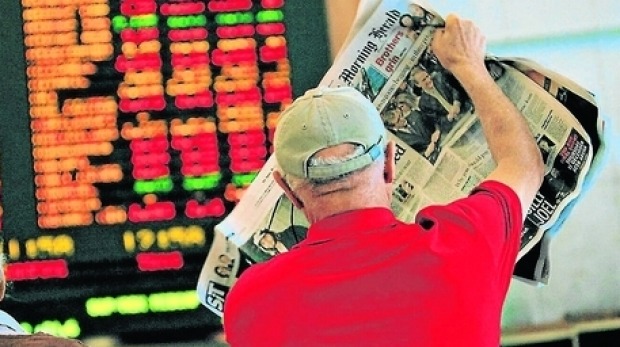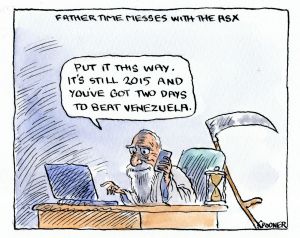
Posted on: 21 Jan 2016
Australia a perennial loser on the global sharemarket
For the tenth year in a row the Australian sharemarket has underperformed most of its global sharemarket peers, ranking 37th out of 73 global exchanges.
Figures compiled by CommSec reveal that the standout performer of 73 exchanges was Venezuela, which ranked number one after the stock exchange ratcheted up a 279 per cent gain over the past 12 months.

Illustration: John Spooner
However, In the case of Venezuela, equities soared 279 per cent between December 31, 2014 and December 22, 2015, largely due to an inflation rate of 160 per cent and the collapse of the currency which prompted many investors to use equities as a hedge against the plunging currency.
The performance of the various exchanges each tell their own story, but a few themes can be drawn including the negative impact of falling commodity prices on countries including Australia, Peru and Canada, while a stimulatory monetary policy across European countries put a rocket under equities. To put it into perspective, six of the top 10 performing exchanges were European countries.
The United States Dow Jones fell 2.3 per cent over the past year, putting it on a ranking of 32, beating 41 countries including Russia, Sweden, Switzerland, Australia and Spain.
The Australian Securities Exchange (ASX) ranked 37 on the back of a 4.1 per cent fall, which wiped billions of dollars from the value of shares and the country's retirement savings.
Most of the ASX's decline was due to the plunging value of mining and energy stocks on the back of falling commodity prices and sharp falls in the big banks following regulatory pressure to boost capital.
However, Australia did outperform Britain's FTSE, which fell 7.5 per cent over the year, giving it an overall ranking of 45. Australia also out-performed the Canadian market, which suffered a negative return of 10.6 per cent, putting it on a ranking 49 and Greece, which fell 25.1 per cent and ranked 69.
This year the Ukraine took the gong from Russia as the worst-performing sharemarket, losing 38.4 per cent on the back of a weak economy, the ongoing conflict in eastern Ukraine and falling global oil prices.
Nevertheless, Australia has been a perennial underperformer for at least a decade.
The CommSec data reveals that Australia underperformed most global markets regardless of the state of the global economies. In 2005 it ranked 53, in 2006 it ranked 39, and at the height of the global financial crisis in 2008 it ranked 33, despite being one of the few developed nations to escape a recession. Not even a mining boom in 2010, 2011 and 2012 pulled Australia into the top 10.
It is a timely reminder of the importance of diversity in asset allocation, particularly self managed super funds which are heavily skewed towards local equities. With more than one million people with a SMSF controlling almost $600 billion, this is an issue.
Indeed, some believe SMSFs are behind the national obsession with dividend yields, which is having a distortionary effect on decisions being made by corporate Australia in terms of capital management: share buybacks and dividend payments versus capital expenditure.
According to a report by Credit Suisse published on December 17, self managed super funds (SMSFs), or "selfies" lost $40 billion in the June and September quarters and are on track to lose another $7 billion in the December quarter due to declines in the equities market.
"By comparison, the rest of superannuation endured capital losses on their Aussie equity positions in the June and September quarters of $25 billion in each. While there were comparable dollar losses, the rest of superannuation suffered smaller losses as a proportion of total assets at only 1.9 per cent per quarter," the report says.
It says the losses suffered by SMSFs over the past three quarters is equivalent to 8 per cent of total assets under management. "Selfies' Aussie equities position equates to about 16 per cent of total market cap. We estimate they are the biggest single group of investors in the Aussie equity market. The next biggest are retail super funds with 11 per cent and then industry funds at 7 per cent. We calculate that superannuation owns almost 40 per cent of the Aussie equity market."
The Australian superannuation industry is now the fourth largest in the world. With more and more people pouring their superannuation savings into SMSF the debate on asset allocation will become increasingly important.
Authorities waded into the debate 18 months ago with concerns that SMSFs were pouring too much into property, helping fuel a property bubble.
The problem for the authorities is that SMSFs are hard to control and regulate because there are so many of them.
To date there are no signs of a systemic failing but with more than 1 million Australians with a SMSF a debate about the rise of SMSFs and the impact they are having on the financial system is an important one to have.
For now, the focus for SMSF will be on the next 12 months and the performance of the ASX as the spotlight turns to interest rates, currency and the outlook for economic growth.